based in Mumbai, a curator and researcher. Her past projects published articles and journals on smell and sound, body and space, and walking through cities, a few of them can be found on this page. Photographs are like punctuation to writings.
Don't wanna be here? Send us removal request.
Text





Participating artists: Gayatri Acharjee Halder, Jyothiraj Mayampilly, Meghna Singh Patpatia, Rashmimala, Sajith CN, Sudhayadas S, Veda Thozhur Kolleri
Presented by: Gallery Dotwalk, Delhi NCR
0 notes
Text

© Shruti Ramlingaiah / 2024 From Through a Hollow Sky and on Open Lines
chilled blue sky and a sun
To know what is real in a city so lit, grids of light demarcate deep dark nights in a view from a landing flight, and the gleaming sun through the day demarcates processes of my brain to fragments. Sitting inside a room, the glass pan window opens to another’s glass shield on the other side. From this high floor, everything and everyone seems to have emptied out. shivering me, frozen toe bones, blanket clad staring out to reflected light, my eyes skim a sharp shadow that speaks of a presence, a solid and concrete. Instantly reminds me of Mohammed Kazem’s clean, sequential triangles plucked on a clean slate of white paper I saw a few days back in a gallery: utterly held light, glowing and supported by shadow. Much of what is the case in Abu Dhabi, walking down the street or looking out of the window appears slate full of sharp cuts on the exteriors while the interior’s carved absent. The other day we discussed how the city has risen in height, coz everything above eye level is attempted by us. The flattening of ground and beneath it gets surpassed for it never holds light; wherein sunsets are an orange tinge of melting gold, gilding building edges. What I captured on my phone, are many others like- pink, purple and scarlet washed on a chilled blue sky - while riding on a bus at around six:PM.
Through a Hollow Sky and on Open Lines is a poetry and photography collection published here as a single-text, created during the RIZQ Art initiative's RAi residency and as part of a field note and adjacent research reflections between memory, cities and ecology in Abu Dhabi, UAE in 2024. These were displayed as visual-prose (alongside three wonderful artists/cohorts) at the Open Studio @MAKEStudios in December as part of this residency.
0 notes
Text

hybrid date palm competing with its natural cousin
It seems my eyes have traced it thrice by now. Keeping a count is a bit tricky, but I exercise it often in a new place or city. Helps draw a landmark to remember a place, a corner in cities that look similar, mostly paved with grid-like layouts. It might cease to be called a landmark unless it were a building or a monument, in which case one could argue otherwise. Every day on the bus to the studio, I confront this tall telecommunication tower - eerie, clad in timeless date palm. One has to look up to see it; it is symbolic. A gesture, in an attire that is connecting, navigational and decorative, cultural connotations and biome tensions. It wears a distinct aesthetics of this place enhancing the landscaping; in its subtly artificial appearance.
After many rounds around this city, it is clear how difficult it can be to eventually spot it. Apparently taller than its natural-cousin which has greyish-white, greenish blue leaves this stands out greener with prominent mobile service provider’s logo displayed at its feet. In the urban landscape, top-view architecture emphasises its road pushing through space and land made to mimic its capitalist ideals. It’s upscale appearance envince its antenna reaching up into the blue sky.
Whether a natural date palm radiates any sense of freshness or the idea of growth seems at odds with how green it appears. The notion of green is tied to growth (inject at least in my mind), isn't it? It's about how lush and varied a tree's features are through changing seasons. Yet, simply being green does not really imbue it with vitality in its presence.
Isn’t the date fruit somewhere between sweet and bitter when freshly plucked? transforming into sweet as it dries. Harvested dates, in their fresh state, are a bit bitter, they say. I recently read an article on food history and culture, exploring how delicious delicacies, like ma'amoul, offer a reward of sweetness. Ma'amoul is known by various names across the Middle East. Traditionally understood as a means of transforming ideas of home, family and gathering, cut to this giant figure mirrors a growing city and embodies a larger, interconnected network with urbanism’s infrastructural vision.
I am reminded of Walter Benjamin's, “The power of country road when one is walking along it is different from the power it has when one is flying over it by aeroplane.” On the other hand, an image comes to mind. 'My Plant Immigrants'—the suspended Mejdoul date palm, chained by its neck, imagine an upside-down chandelier forced into a massive concrete crate—within a polished, defining room, embodies Christopher Joshua Benton's uprooted imagery, questioning migration, labour economies, and identity politics—tough terms to reconcile. How are we informed of palms in our everyday life? Apart from the supermarket shelf or its listed health benefits. Not only raises a jibe about the history of palms: the farmers who harvest and water these trees, where they come from, and how this fruit reaches millions around the world, proposes artist. Through art, certain invisible, uncertain, and disappearing facts can open up new possibilities.
The connection between people remains a theme in the story of palms—whether in a grand hybrid version of interconnectedness or mouth-watering cookies, ma’amoul (those filled with date paste I recently tasted). It also transpires between spectacle and image of welcome in ghosted histories of where it belongs.
References
Doherty, Gareth. (2017) Paradoxes of Green: Landscapes of a City-State: Green Scenery the vertical and the horizontal. 1st ed. University of California Press.
"Maamoul: An Ancient Cookie That Ushers In Easter And Eid In The Middle East", The Salt by Emy E. Robertson, NPR.org, April 2017
"The World was my Garden" Christopher Joshua Benton, https://www.christopherbenton.com/
©Shruti Ramlingaiah / 2024
0 notes
Text
The Unsettling of Ordinary
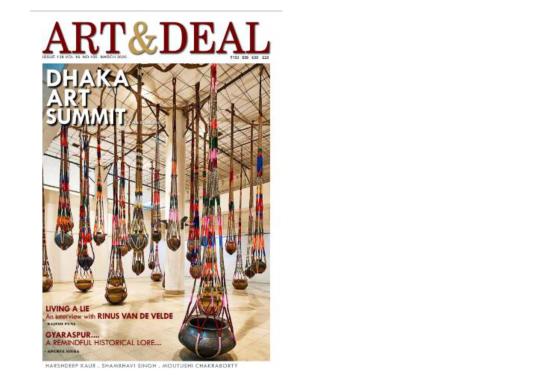
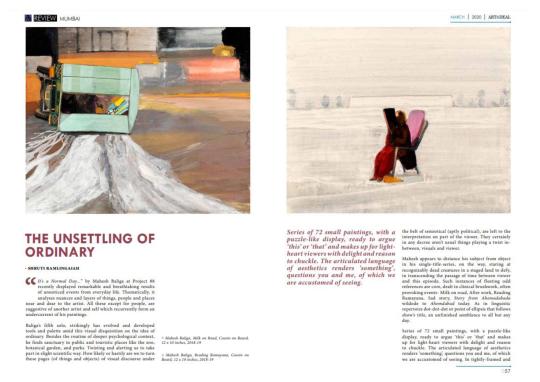
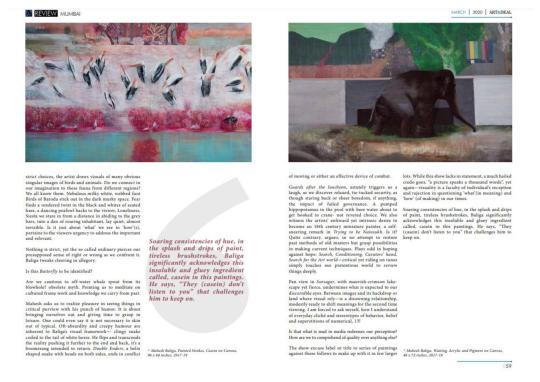
1 note
·
View note
Text
Mūḷ Māthī // from the roots: A Keen Postscript
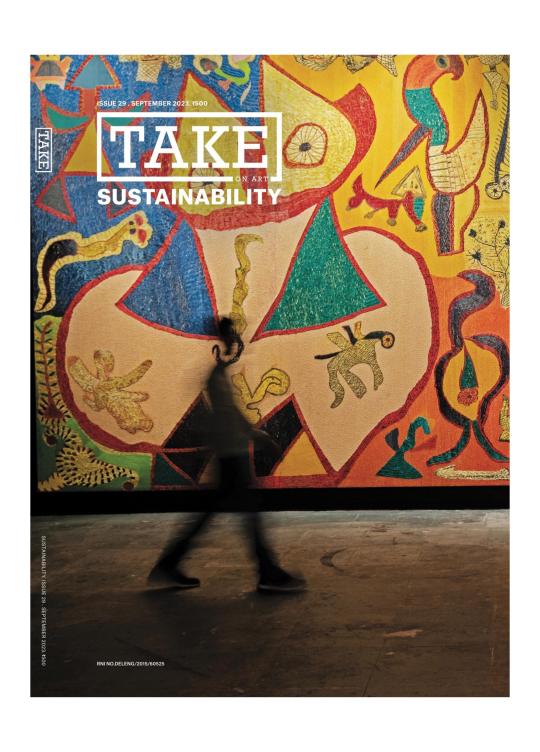
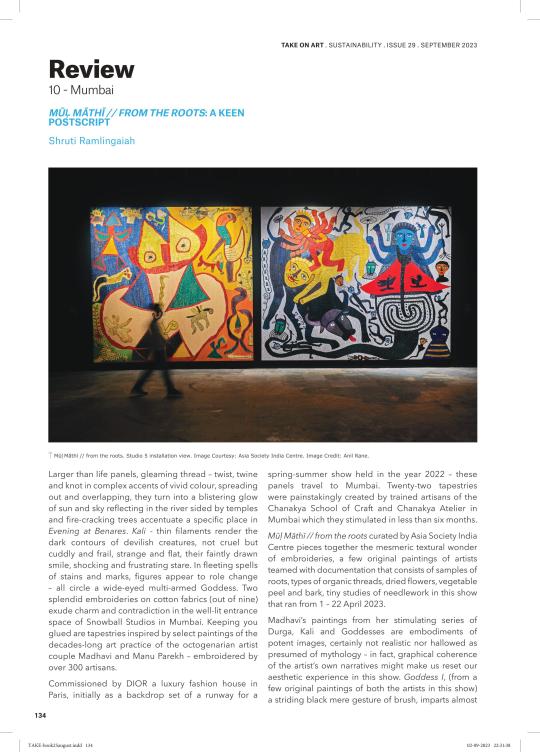
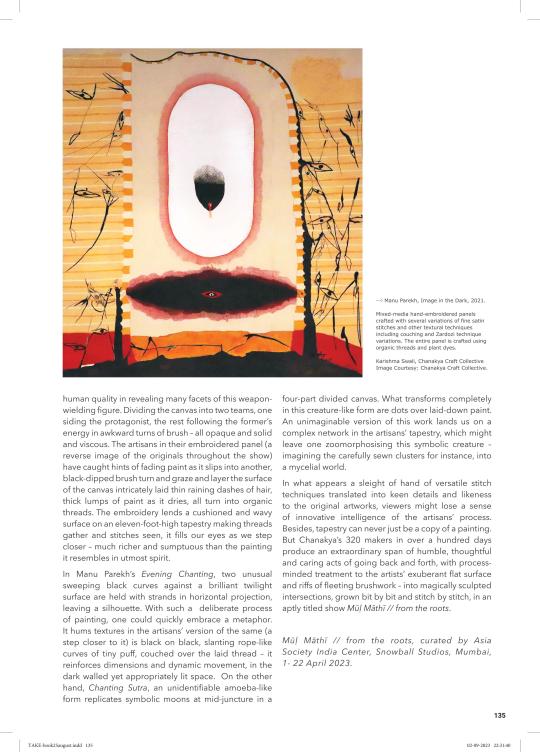
#exhibitionreview#takeonart#mulmathi#madhaviparekh#manuparekh#chanakyaatelier#chanakyaschoolofcraft#mumbai#2023
0 notes
Text
Echoes

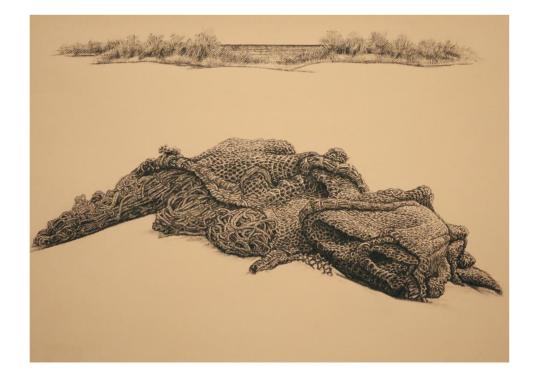
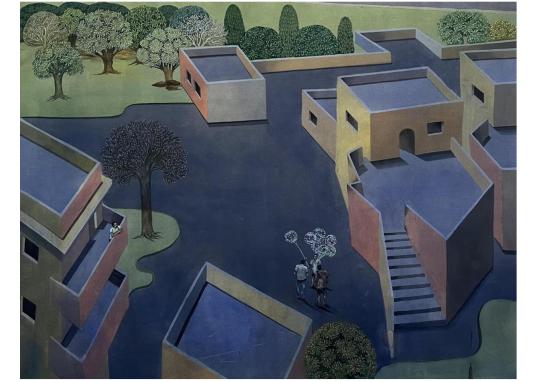
APRE Art House, Mumbai 2022
curated at the APRE in Colaba this was a three-artist exhibition that ran from 4 - 29 November 2022.
An echo is a soundwave that is reflected off a distant surface resonating between different places and times; three artists with differing outlooks and generational affiliations, each setting their distinct approaches to language and individual sensibilities come in dialogue and opposition.
It asks us to contemplate if life is part of a landscape or does life always appears landscape-like.
Featured works by: Pallav Chander, Dhiraj Pednekar, Pavan Kavitkar
#groupexhibition#aprearthouse#colaba#mumbai#pallavchander#dhirajpednekar#pavankavitkar#shrutiramlingaiah
0 notes
Text
Of Separation and Belonging: Sayed Haider Raza
Exhibition review of Zamin: Homelands’, “Of Separation and Belonging: Sayed Haider Raza”, TAKE on Art. Books, Memory Issue 28, 2022
‘Zamin: Homelands’ at the Jehangir Nicholson Art Foundation (JNAF), Mumbai celebrates the birth anniversary of Sayed Haider Raza and the centenary year of the CSMVS (Chhatrapati Shivaji Maharaj Vastu Sangrahalaya) museum that timely coincides with seventy fve years of the country’s independence. It is now more than ever that in the times of mass displacement and migratory movements the question of home or pluralities of co-existence needs to be reconsidered. In this advanced globalised world with ease of travel, cheap airlines, constant travel and issues of homelessness there is a constant strife to come to terms with one’s identity. The show compels us to recall the timelines of our history that draw trajectories to artist’s life and happenings, and social realities of the times. It also makes us think of separation and belonging in a sensitive new era of the aftereffects of partitions. With a few works from the museum, other collections in the city, and archival material from the Raza Foundation the show is curated by Puja Vaish, Director of the JNAF, and ran from 2 June–31 July 2022. The show incorporates texts that are informative, touching anecdotes using letters— written and received—and notes written in Devanagari, French, and English tell of the artist’s assimilation of languages, and varied knowledge of art, literature, poetry and cultures.
Raza was born and raised in a small town in Madhya Pradesh where his father was a forest ranger. His experiences and memories of growing up close to nature and the environment later churned into his incessant brushstroke and dripping in the 70s. The exhibition’s title is taken from a 1971 oil on canvas painting titled Zamina phenomenal gestural work— beams of yellow, orangish red, and green screams from behind the aggregating black fuid that barely cohere of imagery in our eye. While in France during 1960s and 70s, Raza revisited the forest landscapes in India bringing defning compilations from remembered residues of his mind. Almost notating the mild conversations heard from a distance or fery fames visible in the middle of the night.
During 1948–55, Raza turned dramatically lyrical watercolours on paper to paradigms in landscapes— works such as Houses with Medieval Church, Church at Meulen, Mosque being good examples. These works trace diversities in rectilinear views and feature structures drawn from an aerial vantage in the delightful diagonal brushwork. With blocks and broken lines on ochre and brownish grey ground or sky- these architectural constructs sometimes are a dense mass of black, unsubstantial structures, cubist contours or tin-like translucent flatness of burnt sienna, grey and ochres that occupy the blazing ground but, with no specifics of time and place. Scenes in graphite where Raza indefinitely erases and draws (leaving the lines visible than removing them with an eraser), where lines multiply to construct. A few contours define the wall, roof and depth of the structures that hint at the window or door – a pictorial frame looks cohesive as a picture but hardly situates one location in the viewer’s mind. Traced in a scene, Untitled (1952) gouache on paper has a burnt sienna sphere that looms large between the disproportionate structures suspended in cosmic space—it appears like twin cities were split, while they share a sun or a moon telling a mythical tale of light and darkness. As we move through the exhibition, a black dot (we imagine we know so much about it, yet we struggle with its presence) is cosmically framed in the middle of a square, moving, forwarding (in its entirety always) across the plane. Raza’s late works develop many forms of this dot— from an orb in a landscape to a circle, mass, or sun, embedded amid a tile-like mosaic which at times relocates across the plane. The show culminates with a work titled Amar Kantak (1998) with verso text that reads, ‘Amarkantak, Mandala, Kakaiya, Dindori, Niwas, Satpuda, Vindhyachal, Narmada, Narsinghpur… my thoughts and life forces are driven by these (places). Eternal memories. In gratitude to my homeland – Raza.’ Names of these places variously suggest sites of pilgrimage, where mountains collide, rivers meet, and saints had resided. If not human-like, the dot emanates a humanising effect on us as we constantly follow its path in the exhibition. The artist moved away from pictorial constructions in the mid-1950s to experiment with the forms of abstractions—rising from substantial, tangible traces of buildings to attain a full circle to culminate in symbol, motif, geometry which is predictable of a matured seeker in a person. In the show, the artist’s most prodigious works are of the 70s—where he revisits memories in most discomforting brush strokes—in fleeting blobs and dashes across the canvas. The artist’s experiences of nature and land emanate in colours and emotions that echoe his calling in loss and longing for his homeland.
Zamin: Homelands’, Curated by Puja Vaish, Jehangir Nicholson Art Foundation, Mumbai, 2 June–31 July 2022.

0 notes
Text
In the Blink of an Eye
Hosted by the Gallery Dotwalk in Gurgaon, this multi-artist exhibition tendentially gathers ten artists' diverse arrays of work hinting at time as the entanglement of histories, displaced beings, memories of a place, operating through pandemics and shifting urban landscapes.
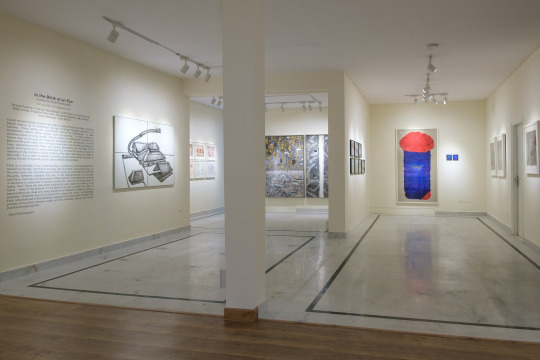
A brief moment exists between the state of wakefulness and sleep, and also before waking up of untethered, blurred, tumbling thoughts capable to us humans. These states are scientifically defined as hypnagogic - a state immediately before falling asleep, and hypnopompic - a state leading to consciousness or being awake. The two states are different in character; the former slips us through an imaginary, fantasised and unconscious moment before drifting into sleep. It is a non-governed state of an individual shutting the brain, dissolving mental filters and slowly dismantling the concepts of the world. All of our models, norms and ideas of a constrained world pull apart its meaning in the slightest of dizzy recalling. The latter state brings us closer to the reality. It is a state of steadily reaching consciousness when we begin to realise the self, things and people, place and the surroundings.
Comparatively, the state of alertness is subjective to human recollection. How do we make sense of reality, then? Does the past mean anything to us in relation to thinking of the future – while in the present? In the Blink of an Eye considers the states of transcending into sleep and being awake as a metaphor to reflect on time as extended, indefinite and an inconsecutive happening, event, and passage. Each artist featured in this exhibition explores the human state of being in the process of transition between reality and the unfamiliar, through their artistic practice and approaches.
Featured works by:
Bhisaji Gadekar(Goa), Chandan Bez Baruah(Guwahati), Jyothi Basu (Vadodara), Kundan Mondal(Vadodara), Midhun Gopi(Kerala),Prajakta Palav Aher(Mumbai), Rachana Nagarkar(Mumbai), Saju Kunhan(Mumbai), Sneh Mehra(Vadodara), Shruti Mahajan(Hyderabad)
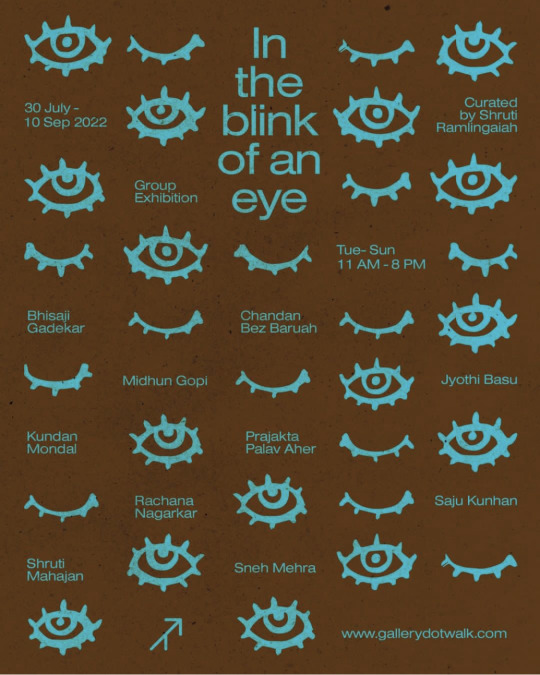
#intheblinkofaneye#groupexhibition#delhi#curation#bhisajigadekar#chandanbezbarua#midhungopi#prajaktapalav#jyothibasu#kundanmondal#rachananagarkar#sajukunhan#snehmehra#shrutimahajan#gallerydotwalk#gurgaon
0 notes
Text
A Moving House or a Landscape
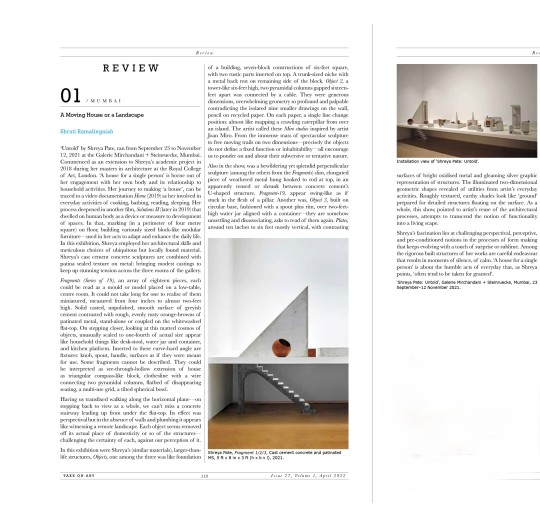
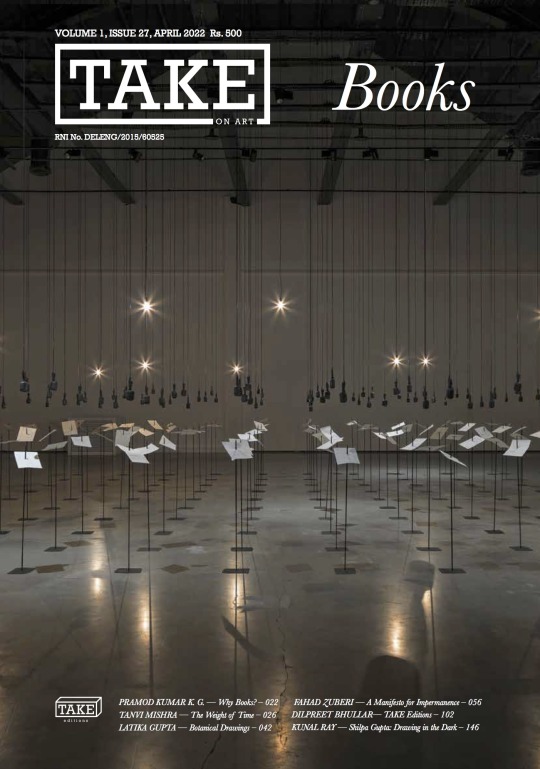
Exhibition review of works by Shreya Pate at Galerie Mirchandani + Steinruecke, Mumbai: “A Moving House or a Landscape”, TAKE on Art. Books, Volume 1, Issue 27, April, 2022
0 notes
Text
Early '00 onwards: Video Art in India
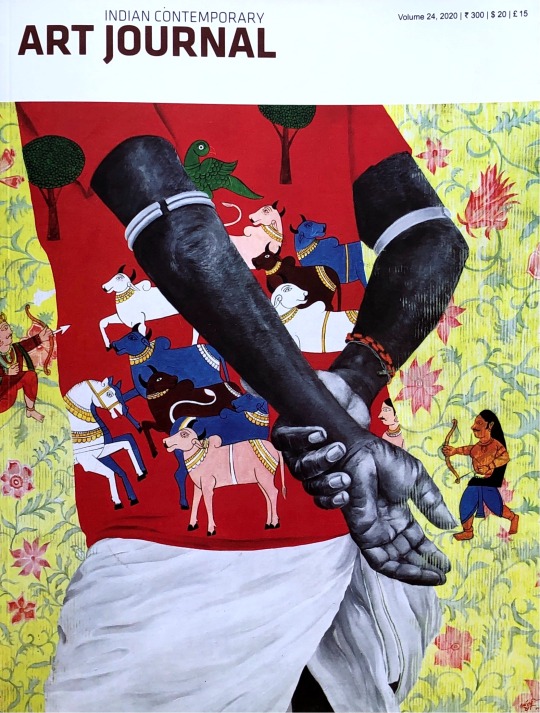
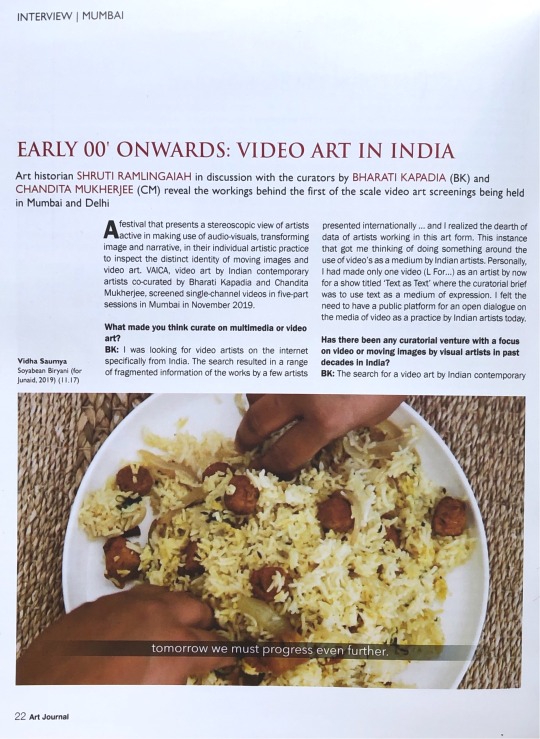
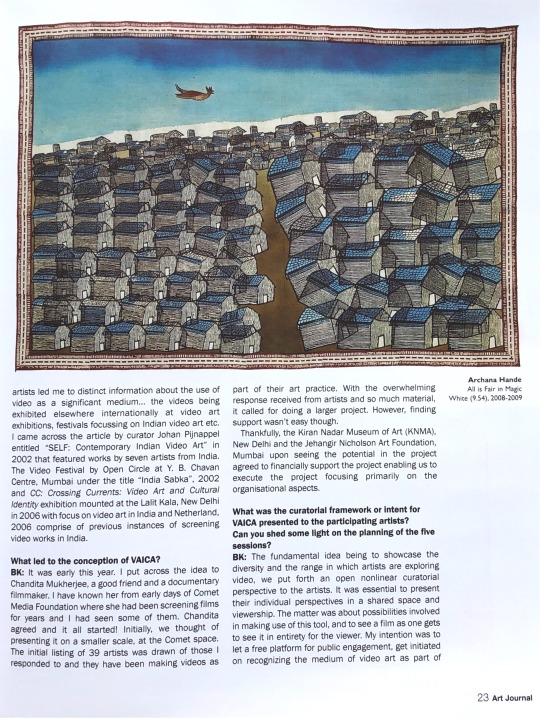
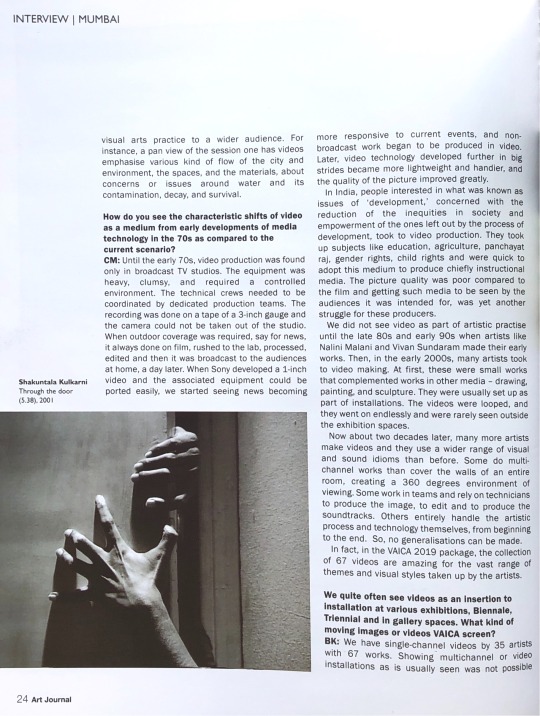
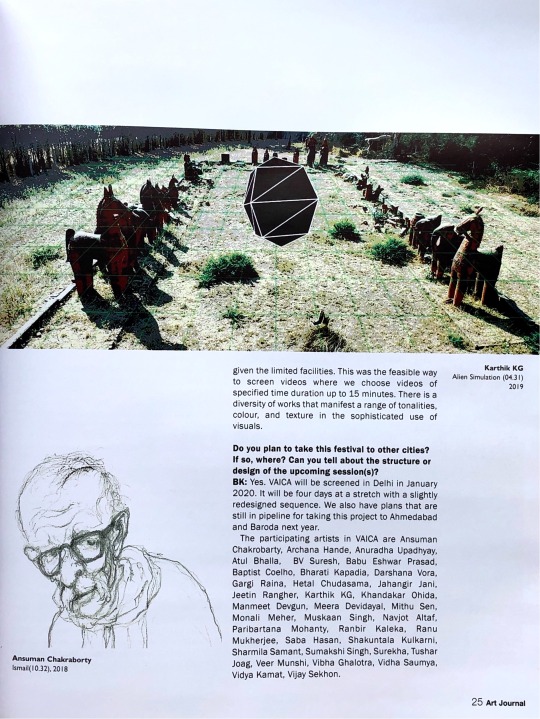
0 notes
Text
The Absent Figure and The Intimate Present
Special Report published in Anthology of Exhibitions, ARTIndia magazine, Volume XXI Issue II, May 2017, 35
A dual display curated by Girish Shahane hinged on two phrases from William Shakespeare’s Hamlet, was hosted by Gallery OED, Fort Kochi, recently. Country Matters, mounted at the Beyond Malabar gallery, from the 9th of December to the 10th of January, reflected contradictory attitudes towards sexuality in a strange yet astute manner. ‘‘Country matters’ is a play on the expression for female genitals. The show had five artists including Mithu Sen, T. Venkanna and Meenakshi Sengupta investigating the voyeur’s gaze, as well as the male gaze.
Send Some Candids by Fabien Charuau used downloaded porn photographs with defaced women, printed on A5 size paper, and hung with sexually suggestive comments found on the Internet. In contrast to Charuau’s deft imagery was Meenakshi Sengupta’s Spices that employed spices as pigments to make stark line drawings of nude women in pornographic poses with text that traversed between niches in the gallery.
Mithu Sen’s part skeleton, part spindly-legged male figures were uncompromising and filled with levity. T. Venkanna’s representation of male and female figures in an installation made of 34 images stuck together probably commented on the display of sexual imagery in public places. Dibin Thilakan’s sole painting worked within an art historical framework and was reminiscent of Aegean paintings, with its composition of ethereal rhythmic figures.This show dwelled on the contentious yet subtle undercurrents of our hypertrophic digital age, and probed the generation and use of slang in the media and everyday life.
Abstract Chronicles that featured works by six artists, from the 10th of December to the 24th of January at Gallery OED, highlighted the excesses of everyday imagery by transmuting them into abstract images. At the entrance, a glimpse of Parul Gupta’s work made you want to re- check whether the vertical lines were still or moving. The canvas with vertical lines, through subtle shifts, provided the viewer with a three-dimensional spatial experience. In an uncanny way the canvas of Sediments by Vibha Galhotra seemed to erupt with a sudden flash of black strokes. By contrast, Tanya Goel’s minimal monochromes Notations (Angle 50 Degrees), were surfaces that blended the excessive material diligently, and deceived the viewer with its imitation of the flickering screen with pixels. Everything is made available to us at one click in this virtual world. Fabien Charuau’s intensely coloured A Thousand Kisses Deep used prolific digital imagery that were processed through an algorithm that could express the energy of pixels in each image. These images were abstract representations of intimate moments like a couple kissing or a crowd praying. Charuau’s algorithms could well have cocked a snook at Georges Seurat in his time! Manish Nai’s print with hazy numerical draping carried layered billboard advertisements that questioned the painted surface and photographic imagery.

0 notes
Text
Pieces
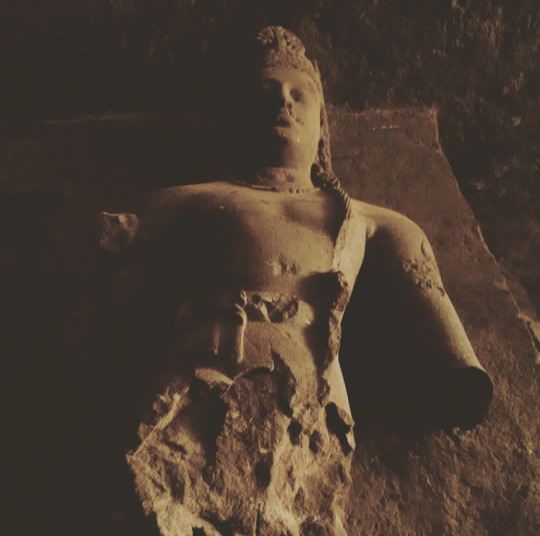
a search for granulate it shreds down, chips of stone seem misplaced by sculptor
though hard and tough: may be it is unfinished, may be have lost to be part of some battle. it might still be trying to stand, a search for sculptor’s hand, in the granulate it has shred down.
chopped, off-posture, limbs struck, a search for shards minced and flown. masses of blow, might still be trying to hold,
monumentality - against spectators and accompanied stoneware.
in-between the gone years, life realises weathered stones and makers absence: remains of slashed strokes, and a smiling face.
no choice but broken shards, intent to finish colossus presence; to humans pride of making and disrupting, peace and disorder but two sides of a similar creature.
0 notes
Text
At the dusk

It is not imperative to establish some ground for everything one encounters or passes by. While this is a small piece that befits an event like a small fragment: it serves as a reminder of how easily events can be forgotten, registered in this digital apparatus from the evening of September 6, 2016. In Fort Kochi Kerala a terrace restaurant, Talk of the Town well known for its obvious location on the corner of the road that faces Santa Cruz-Basilica and for me liked a mild touch of grandmother's hand in their food.
A white structure with ample space to take one's view straight out of the restaurant's window towards the beach; a fading impression of people on the street. The sun had parted to the other side of the earth. While my phone's battery is to rest soon. I go closer, at the window to take a picture or a few. In minutes evening seemed to have turned deep into night for a moment. Squaring off are flashy yellow street lights. The passing of a vehicle left a fleeting image, unknowingly it had given a movement to this picture or rather that instance of deep strange quietness beholds this disappearing ghost - caught in one click.
0 notes